ISSN ONLINE(2319-8753)PRINT(2347-6710)
ISSN ONLINE(2319-8753)PRINT(2347-6710)
B.S.Dayananda1 , S H Manjunath2 , Girish K.B3, L.K.Sreepathi4
|
| Related article at Pubmed, Scholar Google |
Visit for more related articles at International Journal of Innovative Research in Science, Engineering and Technology
In India, the poultry industry is growing at a faster rate. The increase in the demand for chicken meat and eggs has led to the faster growth of the poultry industry. Poultry farms are largely located in rural areas which face scarcity of power. The energy requirements of poultry farms or the poultry industry can be met by utilizing the energy content of the chicken litter through energy conversion technologies. The fluidized bed gasification technique is right choice to utilize chicken litter as energy source. In this paper, a discussion on gasification of chicken litter for different proportions of rice husk is made and was found that the blend of 30% RH and 70% CL was found to yield best quality producer gas.
Keywords |
| Chicken litter, Rice Husk, Gasifier, Fluidized bed Gasification. |
INTRODUCTION |
| In India, the poultry industry is growing at a faster rate. The increase in the demand for chicken meat and eggs has led to the faster growth of the poultry industry [1]. India occupies the third position in the world in chicken meat production and the ninth position in egg production [2]. These industries produce a large amount of waste. It has been estimated that 10,000 birds can produce around 137 tons of dried litter per year [3]. Rice husk is an assured bi-product of agricultural production, mainly available in developing countries, as paddy is their primary food product. The husk produced after extraction from paddy is presently utilized for heating and the rest is used in poultry farms for spreading over the beds [4]. The large quantity of husk obtained from rice industries is utilized as building material, for making panel boards and doors, whereas its thermal and physical properties reveal that it can be utilized as an energy source [5]. The annual output of world energy from rice husk is 1.2 x 109 GJ. Nearly 90,000 rice mills are operating in India, which can produce 10 -20 tons of husk per hour. India alone can produce 22 million tons of rice husks per year. Nearly 100 million tons of rice husk are produced worldwide, 90 percent of it being accounted from developing countries [6, 7]. In the poultry farms, the waste is usually available in the form of a mixture of chicken litter, rice husk, saw dust, etc. This waste has to be disposed of in proper manner. Composting is one way of disposal of chicken litter. If the composted litter is scattered across the fields and as a result, mixes with water, nitrate contamination of water results. The consumption of such water by human beings leads to cancer, lung diseases, etc [8]. Hence chicken litter cannot be utilized as a fertilizer. Poultry farms are largely located in rural areas which face scarcity of power. The energy requirements of poultry farms or the poultry industry can be met by utilizing the energy content of the chicken litter through energy conversion technologies. The energetic value of chicken litter ie., 10,256 kJ/kg indicates that the chicken litter can be utilized as an energy source. [9]. Anaerobic digestion is one method of converting chicken litter into energy. The high Ph value of chicken litter decreases the rate of producer gas production from the digester. Hence it is not advisable to utilize chicken litter as an energy source in the anaerobic digestion process [10]. The high moisture content, the high ash content and the low ash fusion temperature renders the fluidized bed gasification technique the right choice to utilize chicken litter as energy source [11]. In this regard an experimental study on gasification of chicken litter with rice is made in a fluidized bed gasifier. |
II.METHODOLOGY |
| 100 Kg of chicken litter was collected and dried in an open field to achieve the required dryness. Then it was ground and sieved to 850 m. The gasifier chamber was filled up to a height of 30 mm with 850 m of sand. The dried and sieved litter is mixed with the powdered rice husk at different proportions and then feed into the gasifier. The gasifier was initially heated to a temperature of 700 – 8000 C using a Kandal A1 coil. When the coil reached a temperature of 8000 C, the air required for fluidization of sand particles was supplied by using an air compressor and then the chicken litter-rice husk mixture sample prepared for the purpose was added through a manual feeder. The producer gas inside the gasifier chamber was at a slightly higher temperature; hence its temperature had to be reduced to the required level. The gases obtained were passed through a heat exchanger, to be cooled down. The gases consisted of a certain amount of moisture; they had to be reduced before they are utilisation as an energy source. Hence it was made to flow through a calcium chloride chamber. Then, through the vacuum pump, the producer gas generated was made to pass to the four-gas analyzer. The gasifier was operated continuously for 3-4 hours and the compositions of producer gas obtained for different equivalence ratios are measured using four gas analyzer ie., CO, CO2, H2 and CH4and the average value of the results was tabulated in the Table 1, 2, 3 and 4. |
 |
 |
 |
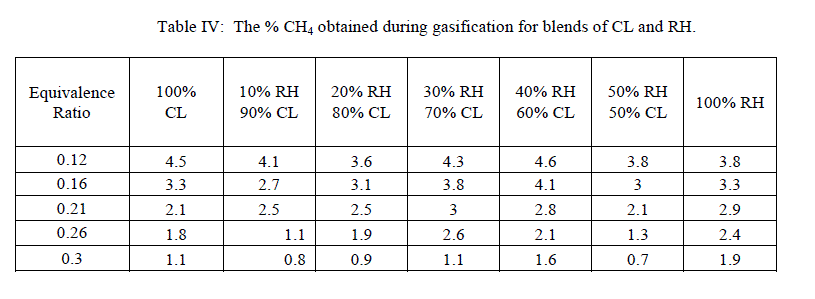 |
III. RESULTS AND DISCUSSION |
 |
| The lower heating value of producer gas obtained for different values of equivalence ratio and different blends of CL and RH is shown in Figure-1. The heating value of producer gas was found to decrease from 4634.4 to 1564.4 KJ/ N m3 with an increase in the equivalence ratio from 0.16 to 0.3 and an increase in the blend from 10% to 50% RH. The blend of 30% RH and 70% CL was found to have a better value than other blends. |
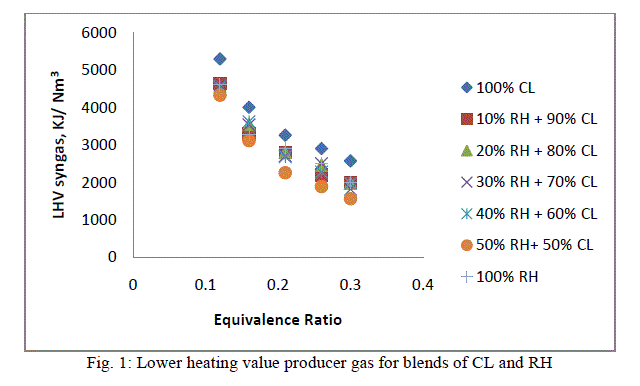 |
| The producer gas obtained from the gasification of CL and RH was meant for utilisation as an energy source at the poultry farm itself. Hence the cold gas efficiency of the gasifier was calculated using the equation 2. |
 (2) (2) |
| The cold gas efficiency of the gasifier was determined for different equivalence ratios for different blends of CL and RH, calculated using equation 2 are plotted in Figure-2. It indicates that with an increase in the equivalence ratio and the mixture composition, a decrease in efficiency from 79.16% to 20.96% was observed. It was observed that cold gas efficiency for a blend of 30% CL and 70% RH was found to be low in comparison with that of others, except in the case of 50% CL and 50% RH. The percentage composition of CO was measured using four gas analyser for chicken litter and with different blends of rice husk for different values of equivalence ratios is shown in Figure-3. It is clear that with an increase in equivalence ratio from 0.16 to 0.3, there was a decrease in CO percentage from 20.9% to 8.5 %. For a blend of 20% RH and 80% CL, the CO composition obtained was found to be significantly higher than that of the other blends, which pointed to the higher heating values of the producer gas. |
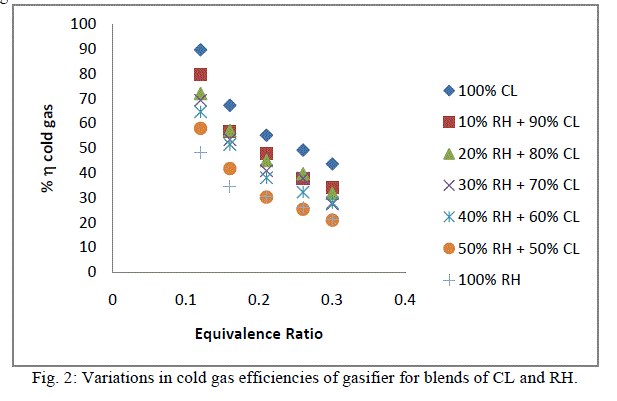 |
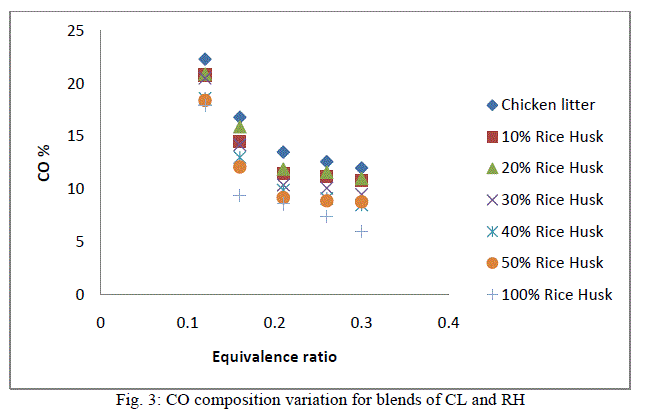 |
| The percentage composition of CO2 was measured using four gas analyser for chicken litter and with different blends of rice husk for different values of equivalence ratios is shown in Figure-4. It was found that an increase in equivalence ratio and blend led to an increase in the percentage of CO2 generation from 6% to 9.5%. The blend of 30% RH and 70% CL was found to produce the highest CO2 composition in comparison with that of the other blends, indicating the highest carbon conversion efficiency. |
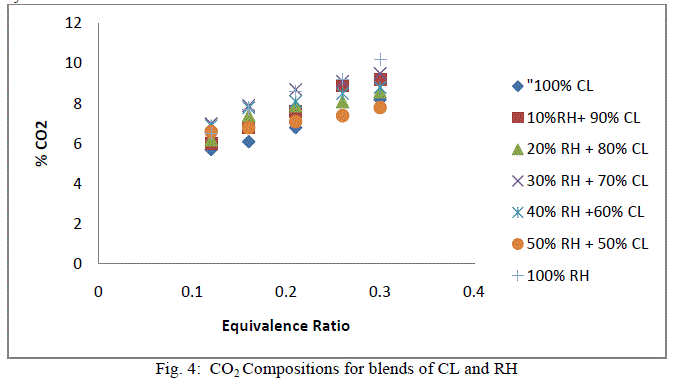 |
| The percentage composition of H2 was measured using four gas analyser for chicken litter and with different blends of rice husk for different values of equivalence ratios is shown in Figure-5. It indicates that with an increase in equivalence ratio, there was a decrease in the H2 production of the producer gas. For 30% RH and 70% CL, the amount of H2 produced was found to be slightly more in comparison with others, indicating the better performance of the gasifier. |
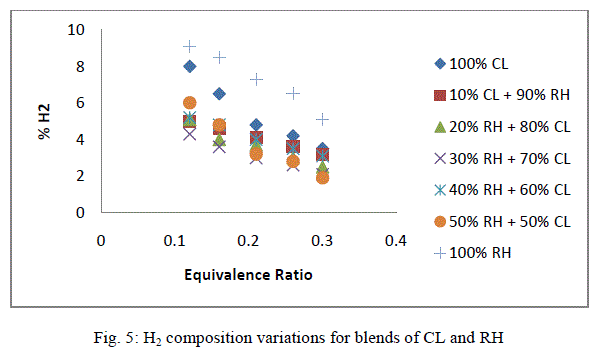 |
| The percentage composition of CH4 was measured using four gas analyser for chicken litter and with different blends of rice husk for different values of equivalence ratios is shown in Figure-6. It indicates that with an increase in the equivalence ratio there was a decrease in CH4 composition from 4.6% to 0.8%. For a blend of 30% RH and 70% CL, a better result emerged in comparison with others, signifying a better gasification process. |
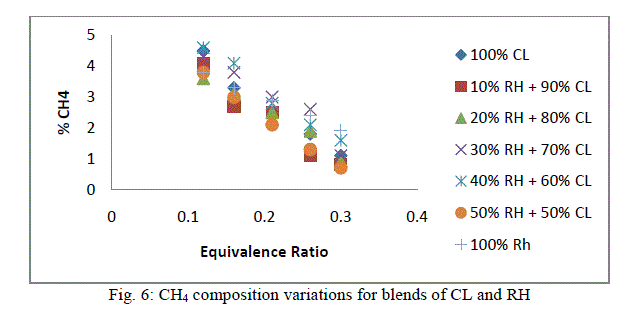 |
IV. CONCLUSION |
| The chicken litter is available in the poultry farms in a mixture form, hence it was planned to test the composition of producer gas for different blends of CL and RH. The test was done for various blends of CL and RH ie, 10% RH and 90% CL, 20% RH and 80% RH, 30% CL and 70% RH and 40% CL and 60% RH, 50% CL and 50% RH. The percentage of CO and CH4 was found to decrease with an increase in equivalence ratio from 0.16 to 0.3. For a blend of 20% RH and 80% CL, the CO composition obtained is found to be predominantly high in comparison with that of other blends. A blend of 30% RH and 70% CL was found to produce the highest CO2 , H2 and CH4 composition in comparison with other blends. It indicates that the heating value of the gas produced for these compositions was also more, namely, 4478 and 4552 KJ/ N m3 respectively for equivalence ratios of 0.16 and 1981.3. It was 1978.6 KJ/ N m3 for an equivalence ratio of 0.3.The cold gas efficiency was found to be more than 50% up to an equivalence ratio of 0.21 and up to a blend of 20% RH and 80% CL. The blend of 30% RH and 70% CL was found to be the best for the gasification of the mixture of CL and RH. Abbreviations:CL- Chicken Litter, RH- Rice Husk. |